climate control Alfa Romeo 156 2004 Owner handbook (in English)
[x] Cancel search | Manufacturer: ALFA ROMEO, Model Year: 2004, Model line: 156, Model: Alfa Romeo 156 2004Pages: 357, PDF Size: 5.04 MB
Page 58 of 357
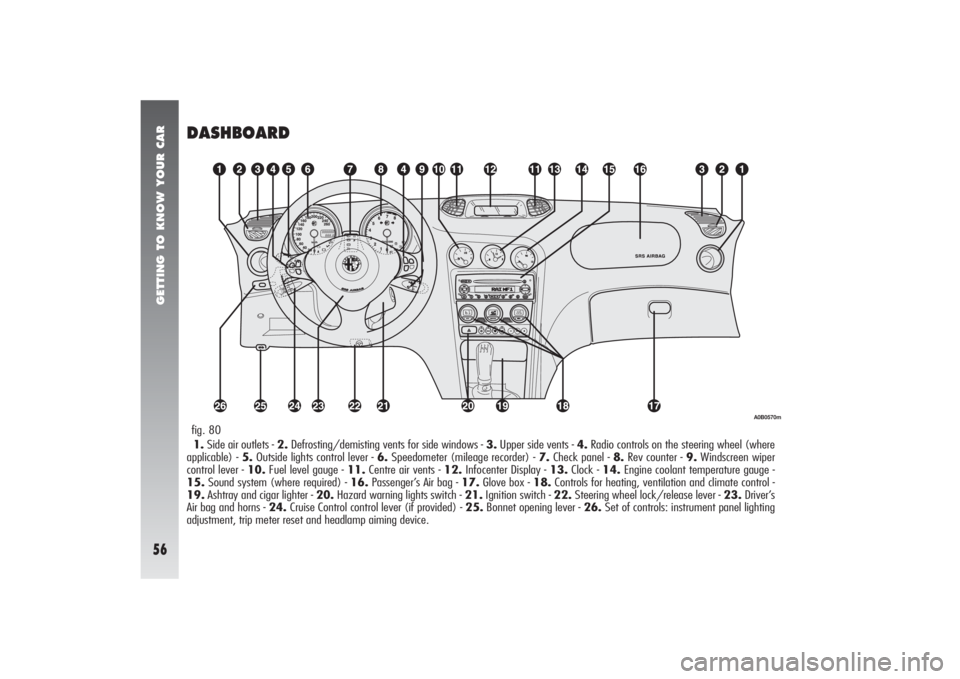
GETTING TO KNOW YOUR CAR56
DASHBOARD1.Side air outlets - 2.Defrosting/demisting vents for side windows - 3.Upper side vents - 4.Radio controls on the steering wheel (where
applicable) - 5.Outside lights control lever - 6.Speedometer (mileage recorder) - 7.Check panel - 8.Rev counter - 9.Windscreen wiper
control lever - 10.Fuel level gauge - 11.Centre air vents - 12.Infocenter Display - 13.Clock - 14.Engine coolant temperature gauge -
15.Sound system (where required) - 16.Passenger’s Air bag - 17.Glove box - 18.Controls for heating, ventilation and climate control -
19.Ashtray and cigar lighter - 20.Hazard warning lights switch - 21.Ignition switch - 22.Steering wheel lock/release lever - 23.Driver’s
Air bag and horns - 24.Cruise Control control lever (if provided) - 25.Bonnet opening lever - 26.Set of controls: instrument panel lighting
adjustment, trip meter reset and headlamp aiming device.fig. 80
A0B0570m
Page 64 of 357
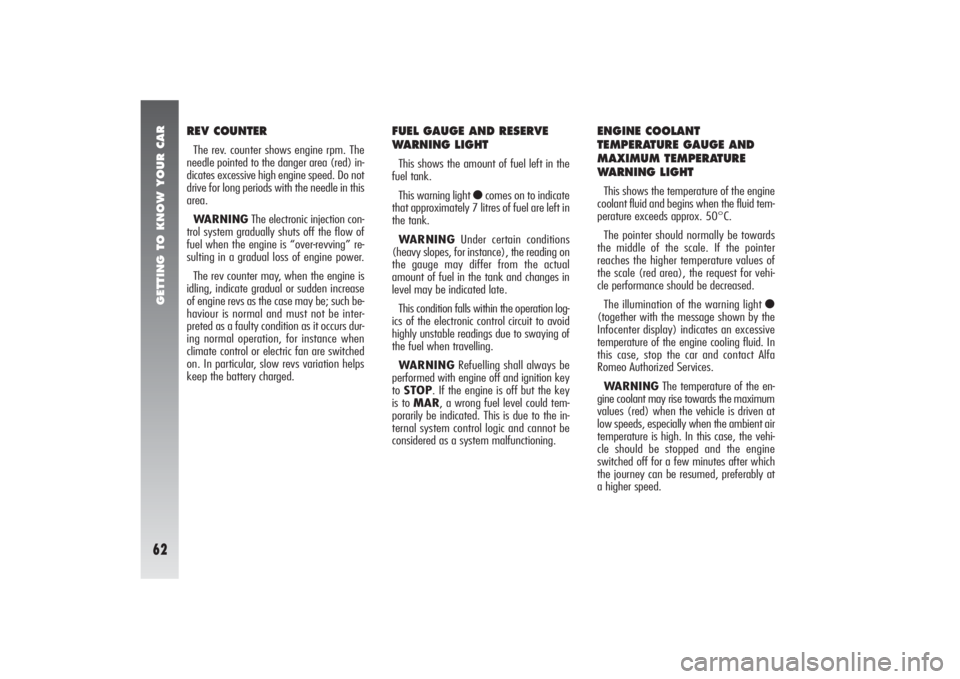
GETTING TO KNOW YOUR CAR62
REV COUNTERThe rev. counter shows engine rpm. The
needle pointed to the danger area (red) in-
dicates excessive high engine speed. Do not
drive for long periods with the needle in this
area.
WARNINGThe electronic injection con-
trol system gradually shuts off the flow of
fuel when the engine is “over-revving” re-
sulting in a gradual loss of engine power.
The rev counter may, when the engine is
idling, indicate gradual or sudden increase
of engine revs as the case may be; such be-
haviour is normal and must not be inter-
preted as a faulty condition as it occurs dur-
ing normal operation, for instance when
climate control or electric fan are switched
on. In particular, slow revs variation helps
keep the battery charged.
FUEL GAUGE AND RESERVE
WARNING LIGHTThis shows the amount of fuel left in the
fuel tank.
This warning light
ç
comes on to indicate
that approximately 7 litres of fuel are left in
the tank.
WARNINGUnder certain conditions
(heavy slopes, for instance), the reading on
the gauge may differ from the actual
amount of fuel in the tank and changes in
level may be indicated late.
This condition falls within the operation log-
ics of the electronic control circuit to avoid
highly unstable readings due to swaying of
the fuel when travelling.
WARNINGRefuelling shall always be
performed with engine off and ignition key
to STOP. If the engine is off but the key
is to MAR, a wrong fuel level could tem-
porarily be indicated. This is due to the in-
ternal system control logic and cannot be
considered as a system malfunctioning.
ENGINE COOLANT
TEMPERATURE GAUGE AND
MAXIMUM TEMPERATURE
WARNING LIGHTThis shows the temperature of the engine
coolant fluid and begins when the fluid tem-
perature exceeds approx. 50°C.
The pointer should normally be towards
the middle of the scale. If the pointer
reaches the higher temperature values of
the scale (red area), the request for vehi-
cle performance should be decreased.
The illumination of the warning light
ç
(together with the message shown by the
Infocenter display) indicates an excessive
temperature of the engine cooling fluid. In
this case, stop the car and contact Alfa
Romeo Authorized Services.
WARNINGThe temperature of the en-
gine coolant may rise towards the maximum
values (red) when the vehicle is driven at
low speeds, especially when the ambient air
temperature is high. In this case, the vehi-
cle should be stopped and the engine
switched off for a few minutes after which
the journey can be resumed, preferably at
a higher speed.
Page 68 of 357
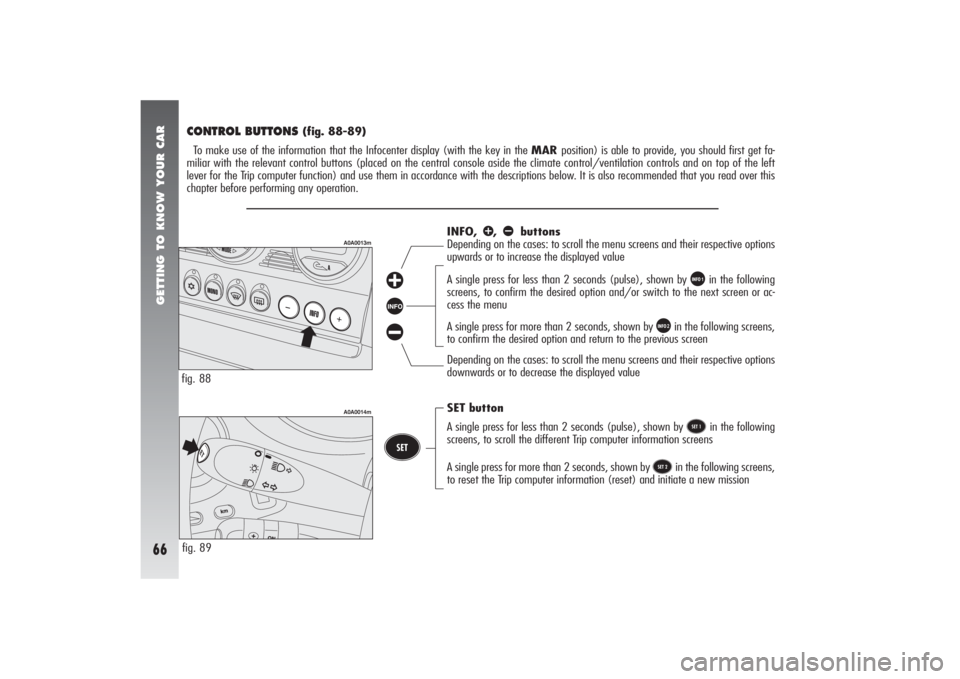
GETTING TO KNOW YOUR CAR66
CONTROL BUTTONS
(fig. 88-89)
To make use of the information that the Infocenter display (with the key in the MAR position) is able to provide, you should first get fa-
miliar with the relevant control buttons (placed on the central console aside the climate control/ventilation controls and on top of the left
lever for the Trip computer function) and use them in accordance with the descriptions below. It is also recommended that you read over this
chapter before performing any operation.
fig. 88fig. 89
ã
SET button
A single press for less than 2 seconds (pulse), shown by
ä
in the following
screens, to scroll the different Trip computer information screens
A single press for more than 2 seconds, shown by
å
in the following screens,
to reset the Trip computer information (reset) and initiate a new mission INFO,
â
, ã
buttons
Depending on the cases: to scroll the menu screens and their respective options
upwards or to increase the displayed value
Depending on the cases: to scroll the menu screens and their respective options
downwards or to decrease the displayed value A single press for less than 2 seconds (pulse), shown by
ç
in the following
screens, to confirm the desired option and/or switch to the next screen or ac-
cess the menu
A single press for more than 2 seconds, shown by
é
in the following screens,
to confirm the desired option and return to the previous screen
A0A0013m
A0A0014m
Page 110 of 357

GETTING TO KNOW YOUR CAR
108
CLIMATE CONTROL SYSTEM1Central defrosting/demisting vents for windscreen - 2Adjustable upper side vents - 3Defrosting/demisting vents for side windows -
4Adjustable side air outlets - 5Adjustable upper vent - 6Adjustable centre, swivel vents - 7Front feet area fixed vents - 8Rear feet area
fixed vents - 9Rear adjustable swivel outlets. fig. 94
A0A0571m
Page 112 of 357
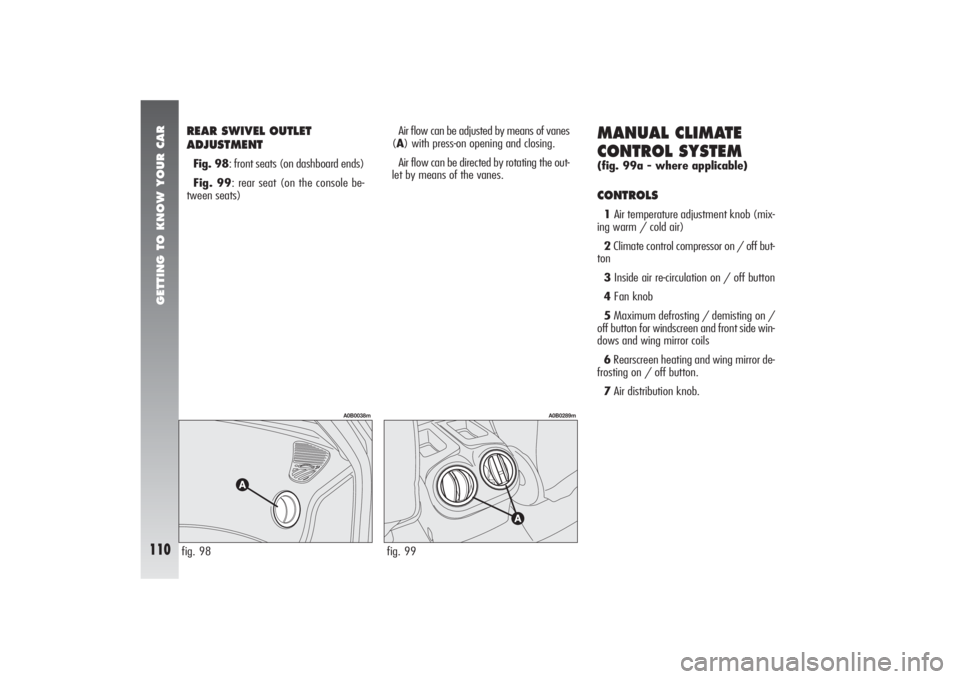
GETTING TO KNOW YOUR CAR
110
REAR SWIVEL OUTLET
ADJUSTMENTFig. 98: front seats (on dashboard ends)
Fig. 99: rear seat (on the console be-
tween seats)
MANUAL CLIMATE
CONTROL SYSTEM (fig. 99a - where applicable)CONTROLS1 Air temperature adjustment knob (mix-
ing warm / cold air)
2Climate control compressor on / off but-
ton
3Inside air re-circulation on / off button
4Fan knob
5Maximum defrosting / demisting on /
off button for windscreen and front side win-
dows and wing mirror coils
6Rearscreen heating and wing mirror de-
frosting on / off button.
7Air distribution knob.
fig. 98
A0B0038m
fig. 99
A0B0289m
Air flow can be adjusted by means of vanes
(A) with press-on opening and closing.
Air flow can be directed by rotating the out-
let by means of the vanes.
Page 113 of 357
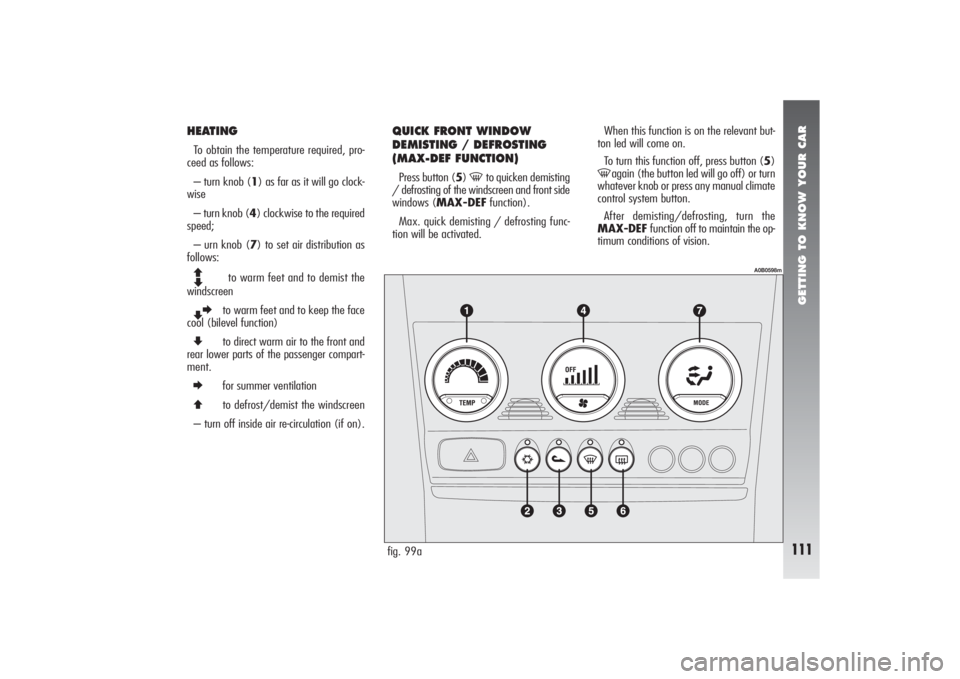
GETTING TO KNOW YOUR CAR
111
HEATINGTo obtain the temperature required, pro-
ceed as follows:
– turn knob (1) as far as it will go clock-
wise
– turn knob (4) clockwise to the required
speed;
– urn knob (7) to set air distribution as
follows:Q
Z
to warm feet and to demist the
windscreen
ZE
to warm feet and to keep the face
cool (bilevel function)
Z
to direct warm air to the front and
rear lower parts of the passenger compart-
ment.
E
for summer ventilation
Q
to defrost/demist the windscreen
– turn off inside air re-circulation (if on).
fig. 99a
A0B0598m
QUICK FRONT WINDOW
DEMISTING / DEFROSTING
(MAX-DEF FUNCTION)Press button (5)
-
to quicken demisting
/ defrosting of the windscreen and front side
windows (MAX-DEFfunction).
Max. quick demisting / defrosting func-
tion will be activated.When this function is on the relevant but-
ton led will come on.
To turn this function off, press button (5)
-
again (the button led will go off) or turn
whatever knob or press any manual climate
control system button.
After demisting/defrosting, turn the
MAX-DEF function off to maintain the op-
timum conditions of vision.
Page 114 of 357
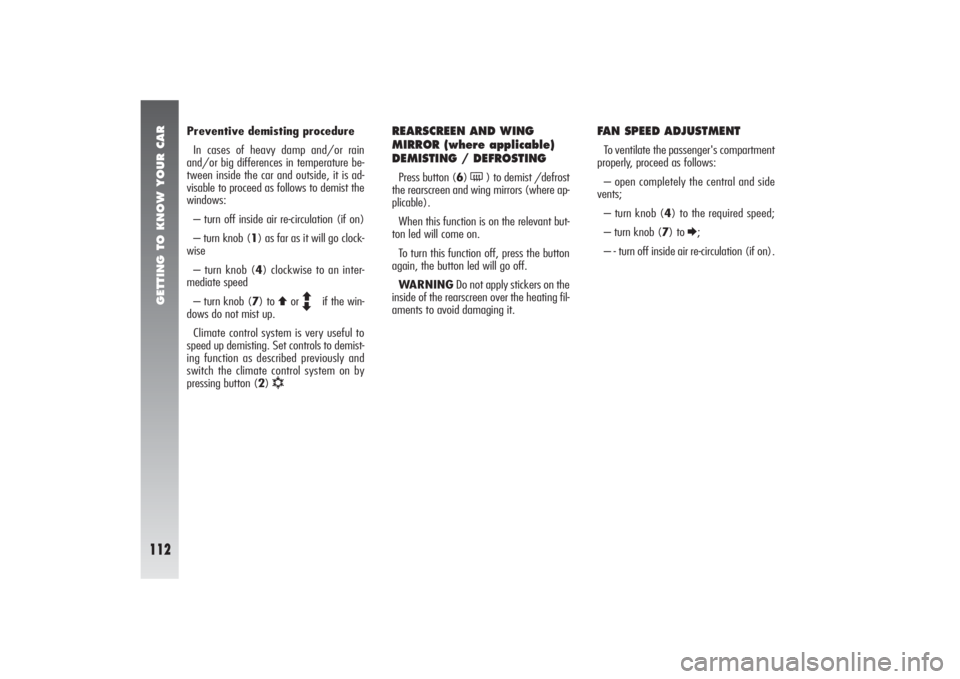
GETTING TO KNOW YOUR CAR
112
Preventive demisting procedure
In cases of heavy damp and/or rain
and/or big differences in temperature be-
tween inside the car and outside, it is ad-
visable to proceed as follows to demist the
windows:
– turn off inside air re-circulation (if on)
– turn knob (1) as far as it will go clock-
wise
– turn knob (4) clockwise to an inter-
mediate speed
– turn knob (7) to
Q
or
ZQ
if the win-
dows do not mist up.
Climate control system is very useful to
speed up demisting. Set controls to demist-
ing function as described previously and
switch the climate control system on by
pressing button (2)
√
REARSCREEN AND WING
MIRROR (where applicable)
DEMISTING / DEFROSTINGPress button (6)
(
) to demist /defrost
the rearscreen and wing mirrors (where ap-
plicable).
When this function is on the relevant but-
ton led will come on.
To turn this function off, press the button
again, the button led will go off.
WARNINGDo not apply stickers on the
inside of the rearscreen over the heating fil-
aments to avoid damaging it.
FAN SPEED ADJUSTMENTTo ventilate the passenger's compartment
properly, proceed as follows:
– open completely the central and side
vents;
– turn knob (4) to the required speed;
– turn knob (7) to
E;
– - turn off inside air re-circulation (if on).
Page 115 of 357
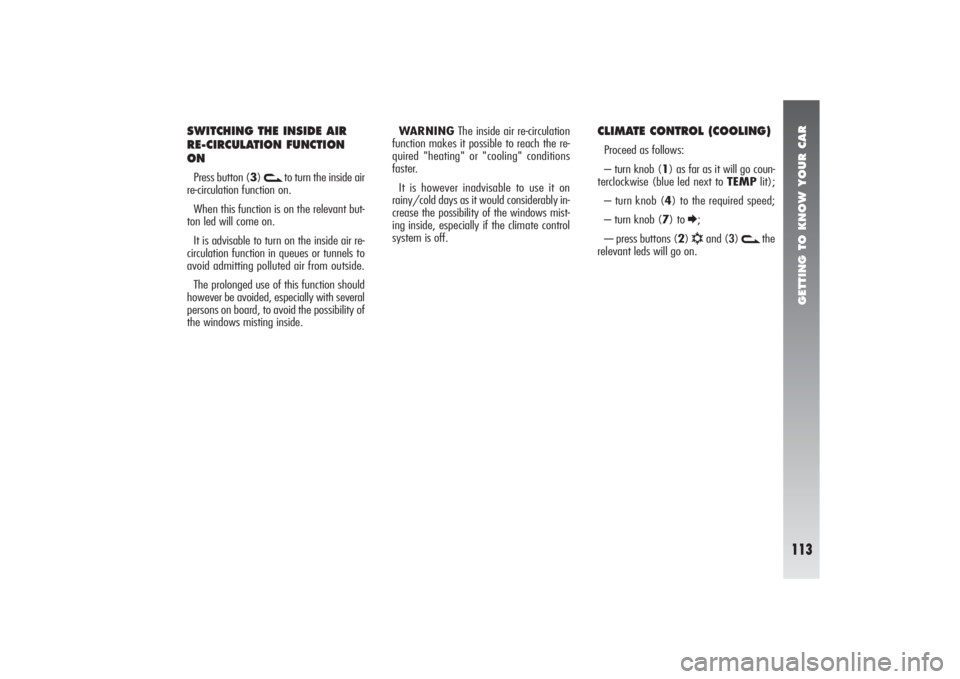
GETTING TO KNOW YOUR CAR
113
SWITCHING THE INSIDE AIR
RE-CIRCULATION FUNCTION
ONPress button (3)
v
to turn the inside air
re-circulation function on.
When this function is on the relevant but-
ton led will come on.
It is advisable to turn on the inside air re-
circulation function in queues or tunnels to
avoid admitting polluted air from outside.
The prolonged use of this function should
however be avoided, especially with several
persons on board, to avoid the possibility of
the windows misting inside.WARNINGThe inside air re-circulation
function makes it possible to reach the re-
quired "heating" or "cooling" conditions
faster.
It is however inadvisable to use it on
rainy/cold days as it would considerably in-
crease the possibility of the windows mist-
ing inside, especially if the climate control
system is off.
CLIMATE CONTROL (COOLING) Proceed as follows:
– turn knob (1) as far as it will go coun-
terclockwise (blue led next to TEMPlit);
– turn knob (4) to the required speed;
– turn knob (7) to
E;
-– press buttons (2) √
and (3)
v
the
relevant leds will go on.
Page 116 of 357

GETTING TO KNOW YOUR CAR
114
Cooling adjustment
Proceed as follows:
– turn off inside air re-circulation (if on);
– turn knob (1) counterclockwise to re-
duce temperature;
– turn knob (4) counterclockwise to re-
duce the fan speed.
LOOKING AFTER THE SYSTEMDuring the winter the climate control sys-
tem must be turned on at least once a
month for about minutes.
Before summer, have the system checked
at Alfa Romeo Authorized Service.
AUTOMATIC
TWO-ZONE CLIMATE
CONTROL SYSTEMTo start the system (fig. 100):
– turn the knob rings to set the required
temperatures (driver’s side – passenger’s
side).
– press the
AUTO
button.
WARNINGThe climate control system
makes it possible to adjust the temperatures
required for the two sides with a maximum
difference of 7°C between the driver’s and
the passenger’s sides.
WARNINGThe climate control com-
pressor works only when the engine is run-
ning and the outside temperature is more
than 2°C.
Page 117 of 357
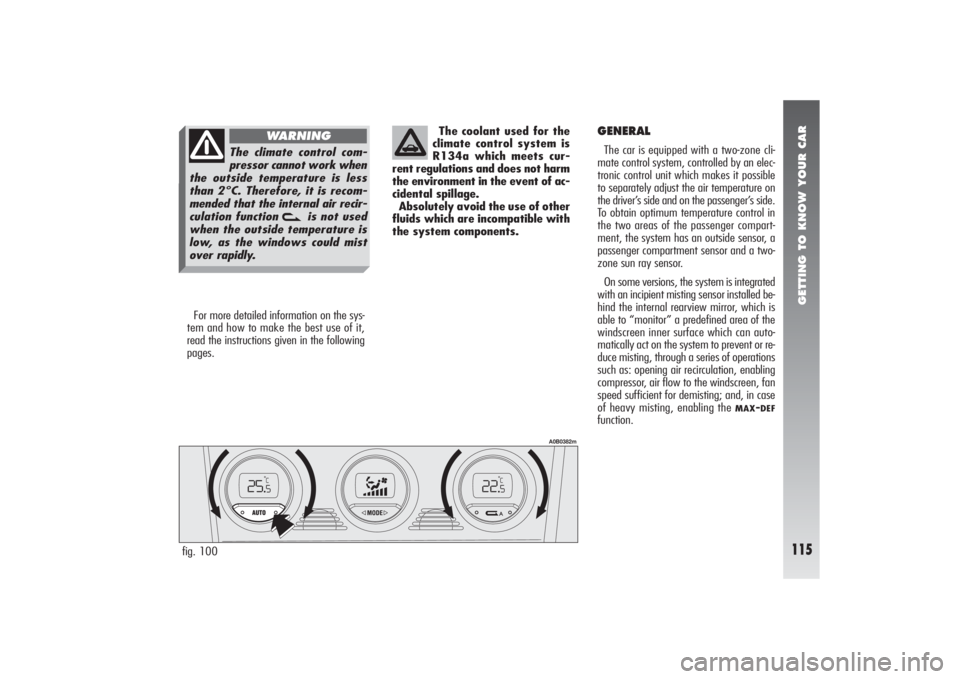
GETTING TO KNOW YOUR CAR
115
For more detailed information on the sys-
tem and how to make the best use of it,
read the instructions given in the following
pages.The coolant used for the
climate control system is
R134a which meets cur-
rent regulations and does not harm
the environment in the event of ac-
cidental spillage.
Absolutely avoid the use of other
fluids which are incompatible with
the system components.fig. 100
A0B0382m
GENERALThe car is equipped with a two-zone cli-
mate control system, controlled by an elec-
tronic control unit which makes it possible
to separately adjust the air temperature on
the driver’s side and on the passenger’s side.
To obtain optimum temperature control in
the two areas of the passenger compart-
ment, the system has an outside sensor, a
passenger compartment sensor and a two-
zone sun ray sensor.
On some versions, the system is integrated
with an incipient misting sensor installed be-
hind the internal rearview mirror, which is
able to “monitor” a predefined area of the
windscreen inner surface which can auto-
matically act on the system to prevent or re-
duce misting, through a series of operations
such as: opening air recirculation, enabling
compressor, air flow to the windscreen, fan
speed sufficient for demisting; and, in case
of heavy misting, enabling the
MAX
-DEF
function.
The climate control com-
pressor cannot work when
the outside temperature is less
than 2°C. Therefore, it is recom-
mended that the internal air recir-
culation function
v
is not used
when the outside temperature is
low, as the windows could mist
over rapidly.
WARNING